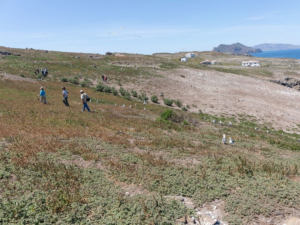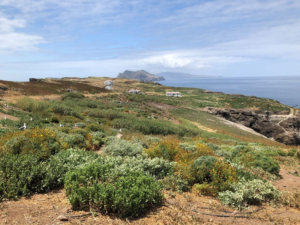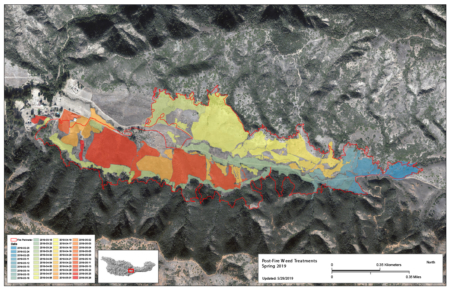Restoration on the Channel Islands
Seabird Habitat Restoration
Since 2007, CIES has been leading an extensive seabird habitat restoration program on Santa Barbara Island in conjunction with Channel Islands National Park (CINP), with primary funding from Montrose Settlements Restoration Program (MSRP), and important assistance from other collaborators and hundreds of volunteers. Since 2016 CIES has rebuilt the nursery on Anacapa Island and began restoring the lighthouse slope there as well. Along with leading these two restoration projects, CIES has worked closely with CINP to restore native habitat to Scorpion Rock, a small islet off of the East side of Santa Cruz Island at Scorpion anchorage. The seabird habitat restoration program aims to increase the amount of suitable nesting habitat for seabirds and other wildlife by removing invasive plant species (primarily crystalline ice plant and non-native annual grasses) and restoring these areas with native plants grown on-island. Between 2007-2015, nearly 10 acres have been restored on SBI by removing invasive plants, and out-planting just under 40,000 native plants grown on island. From 2016-2019, 3.5 acres have been restored on Anacapa Island using the same methods with nearly 15,000 native plants grown and out planted on the island. The target seabird species for this habitat restoration are Scripps’s Murrelets, Cassin’s Auklets, Western Gulls, and California Brown Pelicans. Though these seabird species are our target, many other species benefit from this restoration work including songbirds, pollinators, reptiles, and snails. This restoration work strengthens the biodiversity and resiliency of these important island ecosystems.
Invasive Plant Control
In 2019, CIES took on the Santa Cruz Islands Burn Area Rehabilitation Project in which the goal was to restore the 250 acre burn area on the western side of Santa Cruz Island by controlling the invasive plants such as fennel that came up following the burn. Control methods are a combination of chemical herbicide application, weed-whacking, and hand pulling. The first year was very successful and the CIES crew hit the entire target area (see map). This work will continue for another year in 2020.
CIES is also beginning a project on East Santa Cruz Island in 2020 that will target locating and removing feral olive trees that are scattered around the island from the historic olive grove at Smuggler’s harbor. Stay tuned for update on that project!
Rare Plant Recovery Work
CIES is currently helping with the recovery of one federally endangered plant, Dudleya traskiae, and another rare plant that we hope to keep from being added to the endangered list, Malva assurgentiflora.
Dudleya Traskiae commonly called Santa Barbara Island Live Forever is a native Santa Barbara Island endemic plant that was heavily impacted by human use on the islands such as ranching, introduced species like rabbits, and the spread of non-native weeds across the island. Along with Channel Islands National Park and with funding from the Santa Barbara Botanic Garden and Fish and Wildlife Service, CIES is propagating and outplanting dudleya on SBI to bolster existing populations and create new self-sustaining populations in order to safeguard this species.
Malva assurgentiflora commonly called Island Mallow is another Channel Islands endemic plant that is found only on Anacapa Island and San Miguel Island. We have been growing and out planting the mallow since 2016 in the lighthouse slope restoration site on Anacapa Island. In 2020, we will be working with the Santa Barbara Botanic garden to get a better census and updated genetic information on the existing species to best inform management actions for this species. CIES will be building a nursery on San Miguel Island and growing up to 500 island mallow for out planting in fall 2020!








